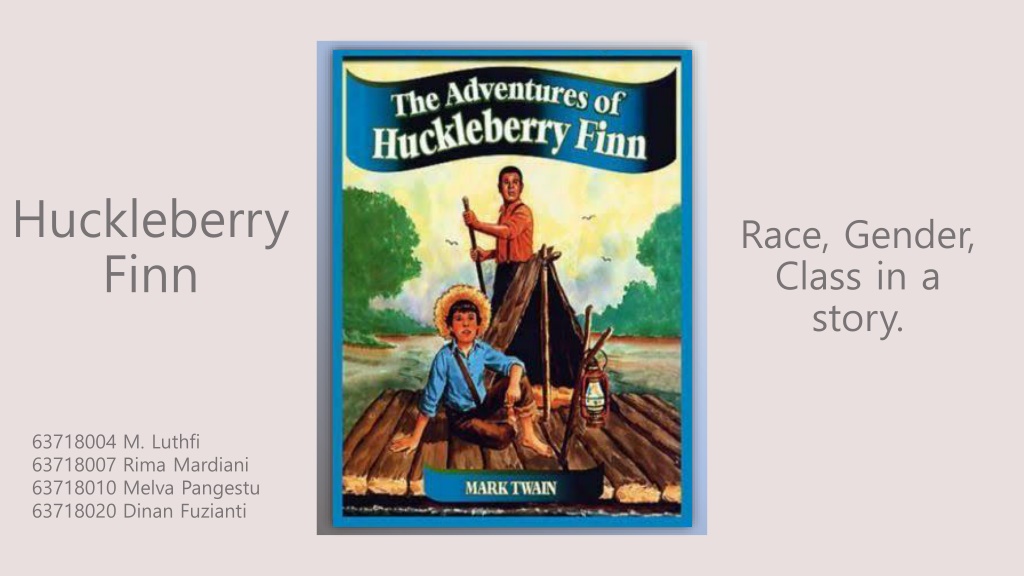Analysis of Race, Gender, and Class in Huckleberry Finn
Huckleberry Finn, written by Mark Twain, explores themes of race, gender, and class through the adventures of Huck and Jim. The story delves into societal perceptions and treatment of different races, the roles of men and women, and the distinctions between social classes. Twain's portrayal of characters and their interactions provides insights into the complexities of these intersecting identities.
Uploaded on Dec 15, 2024 | 0 Views
Download Presentation

Please find below an Image/Link to download the presentation.
The content on the website is provided AS IS for your information and personal use only. It may not be sold, licensed, or shared on other websites without obtaining consent from the author. Download presentation by click this link. If you encounter any issues during the download, it is possible that the publisher has removed the file from their server.
E N D
Presentation Transcript
Huckleberry Finn Race, Gender, Class in a story. 63718004 M. Luthfi 63718007 Rima Mardiani 63718010 Melva Pangestu 63718020 Dinan Fuzianti
Summary Huckleberry Finn is a story writen by Mark Twain. The story is about an ad venture of the boy named Huck and his friend Jim. Huck is a boy who is a bused by his parents and there are Ji m a slave who runaway. They begin their adventure in a Missipipi River a nd learn the story about the people and experiences many things.
01. Race 1. A race is a social grouping of people who have similiar physical or social characteristics that are ge nerally considered by society as forming a distinct group. Schaefer 2. Race is a discursive formation, which delimits so cial relations on the basis of alleged of physical dif ferences. - Smith
Race Analysis Beside the story of the adventure of huckleberry finn we can conclude there are two race in th is story 1. The white people or Caucasian race, like the passage that mentioned in page 222. . The white people or Caucasian race in this nov el described as an aristocratic people and have slave like in this passage that mentioned in pag e 108.
Race Analysis 2. Black race or Negroid people. In this novel the black race or Negroid. In this novel th e black people tagged by nigger word. It reference to the black people who become a slave. Like in this passage that mentioned in page 5.
02. Gender 1. Gender is the relationship between biological sex and behaviour. -Udry 2. Gender is socially constructed and implication s of a culture's dominant models of femininity a nd masculinity. Kimmel & Kaler
1. This passage from Miss Judith Lotus that tell about the difference between boys a nd girls. (page 63-64) 2. In this passage, Twain shows the role of the me n. Men were always be the leader or the head of authority. Twain describing himself as a strict yet kind and an overall leader. (page 108-109)
Gender Analysis 3. This passage is describing about the different between Miss Cha rlotte and her sister, Miss Sophia s personality. Miss Charlotte has a glorious personality, and Miss Sophia has gentle and sweet person ality. (page 109)
03. Class 1. A class is a group with intrinsic tendencies and int erests that differ from those of other groups within society, the basis of a fundamental antagonism betw een such groups - Parkin 2. A class is those who share common economic int erests, are conscious of those interests, and engage i n collective action which advances those interests - Andrew
Class Analysis Based on the whole story we can conclude : There are four class issue in this book First is the aristocrat class the wealthiest class represent by Grangerfords in page 110 and 112
Second is class that can own their slave which is represent by white people Third is the normal class which is represent by Huck which doesn t have slave. Fourth is the lowest class, the black people which is working as slave like Jim.
References Schaefer, R. T. (2008). Encyclopedia of race, ethnicity, and society (Vol. 1). Sage. Smith, D. L. (1984). Huck, Jim, and American Racial Discourse. Mark Twain Journal, 22(2), 4-12 Udry, J. R. (1994). The nature of gender. Demography, 31(4), 561-573. Kimmel, M. S., Aronson, A., & Kaler, A. (Eds.). (2008). The gendered society reader. New York, NY: Oxford Uni versity Press. Parkin, F. Marx s Theory of History: A Bourgeois Critique. New York: Columbia University Press, 1979. Andrew, E. (1983). Class in itself and class against capital: Karl Marx and his classifiers. Canadian Journal of P olitical Science/Revue canadienne de science politique, 577-584.





























